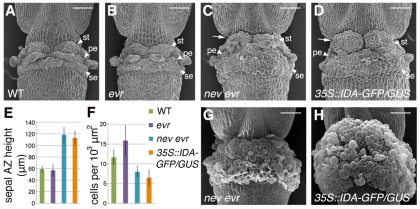Fig. 3.
Ectopic AZ cell expansion occurs in nev evr flowers. (A-D) Scanning electron micrographs (SEMs) of flowers immediately after organ separation (first stage 17 flower). Owing to increased cell expansion and the presence of additional cells, nev evr flowers (C), like flowers constitutively expressing IDA (D), develop larger AZs than do wild-type (A) and evr (B) flowers, which cover the stem-like gynophore of the fruit (arrows). (E,F) Quantification of AZ size (E) and cell expansion (F) in wild-type and mutant flowers (n≥4, second stage 17 flower). In nev evr and 35S::IDA-GFP/GUS flowers, the average heights of the sepal AZs are 2-fold greater than those of wild-type or evr flowers (E). A decrease in the number of sepal AZ cells in a defined area was observed for nev evr and 35S::IDA-GFP/GUS flowers compared with wild-type and evr flowers, suggesting that cell expansion contributes in part to the increase in AZ size (F). (G,H) The expanding AZs of older nev evr (G) and 35S::IDA-GFP/GUS (Col) (H) flowers (stage 17) envelop the nectaries and form visible collars of tissue at the fruit bases. The sepal (se), petal (pe) and stamen (st) AZs cannot be distinguished. Scale bars: 100 μm.

